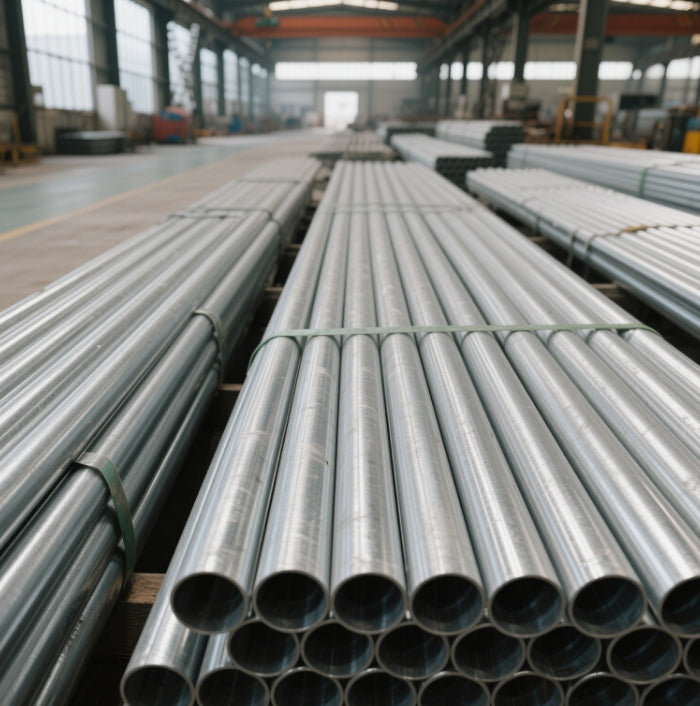StockSteel
HVAC-Ready galvanized pipe fittings | Air Duct & Ventilation Systems
HVAC-Ready galvanized pipe fittings | Air Duct & Ventilation Systems
Couldn't load pickup availability
HVAC-Ready Galvanized Pipe Fittings | Air Duct & Ventilation Systems
Product Overview
HVAC-ready galvanized pipe fittings are engineered for seamless integration into modern air duct and ventilation systems, offering unmatched durability and corrosion resistance. These fittings are ideal for commercial HVAC installations, industrial exhaust systems, and residential ventilation networks. The hot-dip galvanized coating ensures long-term protection against rust, moisture, and environmental wear, making them a reliable choice for demanding applications.
Technical Specifications
| Parameter | Details |
|---|---|
| Material | Carbon steel (ASTM A53) with hot-dip galvanized coating (≥80μm zinc) |
| Size Range | ½" to 24" (DN15–DN600) |
| Pressure Rating | 300–6000 PSI (ASME B16.11, ISO 4144) |
| Hardness | 150–200 HV (Vickers) |
| Surface Treatment | Hot-dip galvanized, passivated for enhanced corrosion resistance |
| Process | Cold forging, threading, precision machining, ISO-certified QC |
Key Features
1. Tensile & Bend Strength
Tensile strength (400–550 MPa) ensures resistance to internal pressure and mechanical stress, critical for high-pressure HVAC systems. Bend strength (300–450 MPa) prevents deformation under lateral loads, maintaining structural alignment even in complex duct layouts.
2. Identification & Marking
Fittings are laser-etched with ASTM standards (e.g., A53, A123), size, pressure rating, and batch number for traceability and compliance with building codes.
3. Weight Calculation
Weight (kg/m) = (OD² – (OD – 2×WT)²) × 0.02466
Example: For a 4" (114.3mm OD) pipe with 4.5mm wall thickness:
(114.3² – 105.3²) × 0.02466 ≈ 11.25 kg/m.
4. Why Stainless Steel Can Rust
While stainless steel resists corrosion, chloride exposure (e.g., coastal air), mechanical abrasion, or high-temperature oxidation can degrade its passive chromium oxide layer, leading to localized rust. Regular cleaning and avoiding contact with carbon steel tools mitigate this risk.
Installation & Maintenance Insights
Welding Galvanized Steel Pipe
Welding galvanized steel pipe requires removing the zinc coating near the weld area to prevent toxic fumes and porosity. Use grinding tools to strip 1–2 inches of the galvanized layer, then weld using ER70S-6 electrodes for optimal results. Post-weld, apply zinc-rich paint to restore corrosion resistance.
What Are Galvanized Pipes?
What are galvanized pipes? These are carbon steel pipes coated with a zinc layer via hot-dip or electroplating processes. The zinc acts as a sacrificial anode, protecting the underlying steel from rust. Commonly used in HVAC, plumbing, and industrial systems, they offer a cost-effective solution for moderate-corrosion environments.
Why Are Galvanized Pipes a Problem in Older Homes?
Why are galvanized pipes a problem in older homes? Over decades, zinc coatings erode, exposing the steel to rust and mineral buildup. This reduces water pressure, causes leaks, and contaminates water with rust particles. In HVAC systems, corroded ducts compromise airflow efficiency and indoor air quality.
Why Choose Our Stainless Steel Solutions?
-
Superior Corrosion Resistance
Our 304/316L stainless steel fittings withstand chloride-rich environments (e.g., coastal HVAC systems) and high humidity, outperforming galvanized alternatives. -
Zero Maintenance & Longevity
Stainless steel requires no recoating or rust removal, reducing lifecycle costs by 40% compared to galvanized systems. -
Eco-Friendly & Recyclable
Stainless steel is 100% recyclable, aligning with green building certifications like LEED and BREEAM. -
Certified Compliance
All products meet ISO 9001, ASTM A312, and EN 10217-7 standards, ensuring reliability in fire protection and HVAC applications. -
Customization Options
Tailor-made solutions for non-standard sizes, pressure ratings, and alloy compositions (e.g., duplex stainless steel for extreme temperatures).

